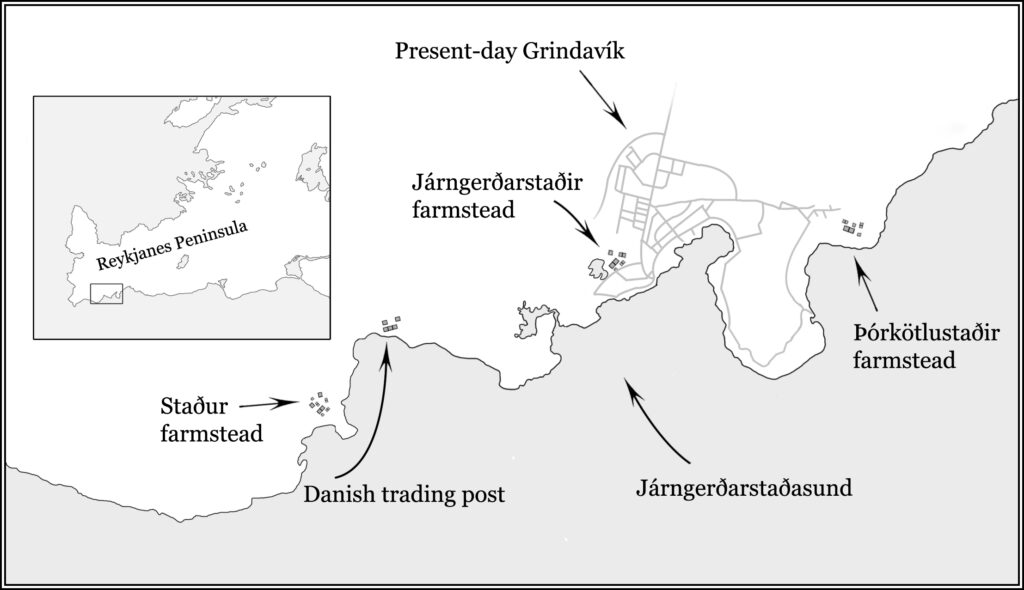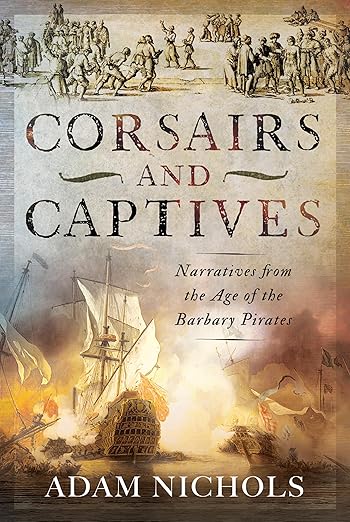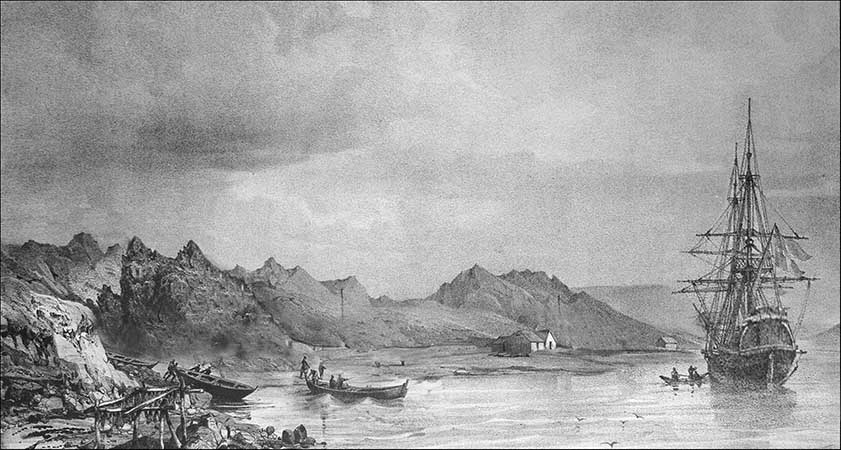This week we look at yet another European captive who was hauled off to Algiers and enslaved there. This one, too, was an Icelander. His name was Helgi Jónsson.
In late June of 1627, Barbary corsairs raided the village of Grindavík on the southwest coast of Iceland. These corsairs had come from Salé, on the west coast of Morocco, a sailing distance of something like 2,000 miles (3,300 kilometers), much of it across the heaving North Atlantic.
In the early seventeenth century, Iceland had no cities. It didn’t even have much in the way of towns. Mostly, people lived in individual farms or in small communities along the coast. Grindavík, located on the southern shore of the Reykjanes Peninsula in Iceland’s southwest corner, was one such community. Grindavík wasn’t even a village in those days. It was just a settlement: three farms and a Danish trading post (Iceland was a Danish possession at the time and the Danes exercised a complete monopoly over trade).
One of the farms was known as Járngerðarstaðir (pronounced Yawrn-gerthar-stathir). Járngerðarstaðir literally means “iron-making area,” for there had once been an iron foundry there back in the days of the Vikings, or so the story goes, anyway). The Icelandic Church owned Járngerðarstaðir Farm, but it was run by one of the most important families in the area. It was a large farm and the most prosperous of the three Grindavík farmsteads. (See the map below for a sense of what Grindavík looked like back then.)
 As I’ve mentioned before, the lives of European captives enslaved in Algiers remain mostly anonymous and unchronicled. A few famous men (like Miguel De Cervantes, author of Don Quixote) wrote about their experiences. Helgi Jónsson wasn’t famous. He was, however, a member of the Járngerðarstaðir farm family. Thanks to a series of seventeenth century Icelandic documents that were created while events were still fresh in people’s memories—two of them penned by members of the family—we can trace the details of what happened to the Járngerðarstaðir Farm family on that fateful June day and afterwards.
As I’ve mentioned before, the lives of European captives enslaved in Algiers remain mostly anonymous and unchronicled. A few famous men (like Miguel De Cervantes, author of Don Quixote) wrote about their experiences. Helgi Jónsson wasn’t famous. He was, however, a member of the Járngerðarstaðir farm family. Thanks to a series of seventeenth century Icelandic documents that were created while events were still fresh in people’s memories—two of them penned by members of the family—we can trace the details of what happened to the Járngerðarstaðir Farm family on that fateful June day and afterwards.
__________
In the incandescent light of an early northern summer morning, the Salé corsairs dropped anchor in Járngerðarstaðasund (“sund” is “sound” or “channel,” in Icelandic, so “Járngerðarstaðasund” refers to the sound or channel near Járngerðarstaðir—see the map above). Given the fearsome reputation of Barbary corsairs, you’d expect them to have immediately swarmed ashore and violently attacked everybody and everything in sight.
They did not.
Instead, being experienced plunderers, they first took time to reconnoiter.
Nearing the end of June as it was, the summer shipping season was well advanced, and it was common for vessels from various places—England, France, Denmark, Norway, the German Hanseatic towns—to cruise Icelandic waters in the relatively warm summer months, so the appearance of a strange ship was not, by itself, cause for any immediate alarm.
The Salé corsairs sent men over in a ship’s boat to talk politely with the captain of a Danish merchant ship, manned only by a skeleton crew, that lay moored in Járngerðarstaðasund. They lied to the captain, telling him they were whalers who had been blown off course, and used the opportunity to find out about the state of things ashore. Then they rowed back peaceably to their ship.
At this point, the Danish factor (the official Danish representative in charge of the trading post at Grindavík) sent out eight men in a rowboat to see who the newcomers might be. As they clambered aboard the corsair ship, all eight of these men were overwhelmed and taken prisoner. One of them was Helgi’s uncle, Jón Jónsson—the first of the family to be seized.
The Salé corsairs then captured the moored Danish merchant ship—a simple enough task, since almost all of its crew were ashore—and took whatever they could from it in the way of weapons and supplies.
Then they rowed ashore and attacked the settlement of Grindavík.
The leader of these Salé corsairs was a Dutch renegado (a Christina convert to Islam) named Jan Janszoon van Haarlem—known by his Islamic name as Morat Reis (Captain Morat). He would have had a crew of about eighty men, fifty or sixty of whom he could put ashore in the attack. Such a horde of well-armed corsairs would have easily overwhelmed the place.
Barbary corsairs have a reputation for merciless brutality, but the primary goal of an attack like this was intimidation rather than death and destruction. Whatever else it might have been, the corsair enterprise was a business enterprise. Morat Reis and his men would have leaped ashore from their boats, brandishing cutlasses, scimitars, muskets, pistols, and lances, shrieking and howling… all of it a calculated show intended to terrify their victims into cowering submission.
A certain amount of brute violence might have been inevitable—especially if people tried to resist—but, whenever feasible, they would have avoided seriously harming their victims. They wanted uninjured captives that would fetch as high a price as possible in the slave market.
Coming ashore in a wave, the corsairs quartered the area, taking whatever and whomever they could.
Of the Járngerðarstaðir Farm family, they captured not only Helgi, but also his mother, Guðrún, his uncles Halldór and Jón (the same Jón who had rowed out to the corsair ship and been taken), and his two brothers, the elder one, Jón, and the younger, Héðinn. Two of Helgi’s other uncles, Philippus and Hjálmar, were killed in the raid as they tried to protect their sister (Helgi’s mother). The corsairs also rounded up Helgi’s father, Jón Guðlaugsson, who was herded down to the beach along with his sons and Halldór. Jón was too old, though, and he was, apparently, sick to boot. The corsairs saw no profit in taking him, so they left him behind, prostrate on the beach.
With that, their ship loaded, Morat Reis gave orders to weighed anchor, and the corsairs sailed away.
In the space of a few short hours, the comfortable prosperity and promising future of the Járngerðarstaðir Farm family had been utterly destroyed.
Chained together in the hold of the corsair ship, traumatized and exhausted, those taken captive were now facing the prospect of being sold in slavery, after that, of enduring lives of hard servitude.
__________
After a long month at sea, they arrived in Salé at the beginning of August.
In the late 1620s, Salé was a thriving corsair port, home to a pirate fleet of thirty or forty vessels, with close connections to other North African corsair ports, especially Algiers. The town itself had a population of perhaps 15,000 people. A significant proportion of these were slaves.
The Icelanders were brought ashore and paraded through the streets as a way of advertising that they were up for sale. Then they were auctioned off in the slave market, each to the highest bidder—exactly the same process as that which occurred in Algiers.
Helgi was initially bought in the slave market in Salé. Somehow, though—exactly how isn’t clear—he and his older brother, Jón, ended up in Algiers.
Which is why he’s included in this series of posts about the enslaved captives’ experiences in Algiers.
_____
We’ll pick up the story of what happened to Helgi in Algiers next week.

Corsairs and Captives
Narratives from the Age of the Barbary Pirates
View Amazon listing
The Travels of Reverend Ólafur Egilsson
The story of the Barbary corsair raid on Iceland in 1627
View Amazon listing